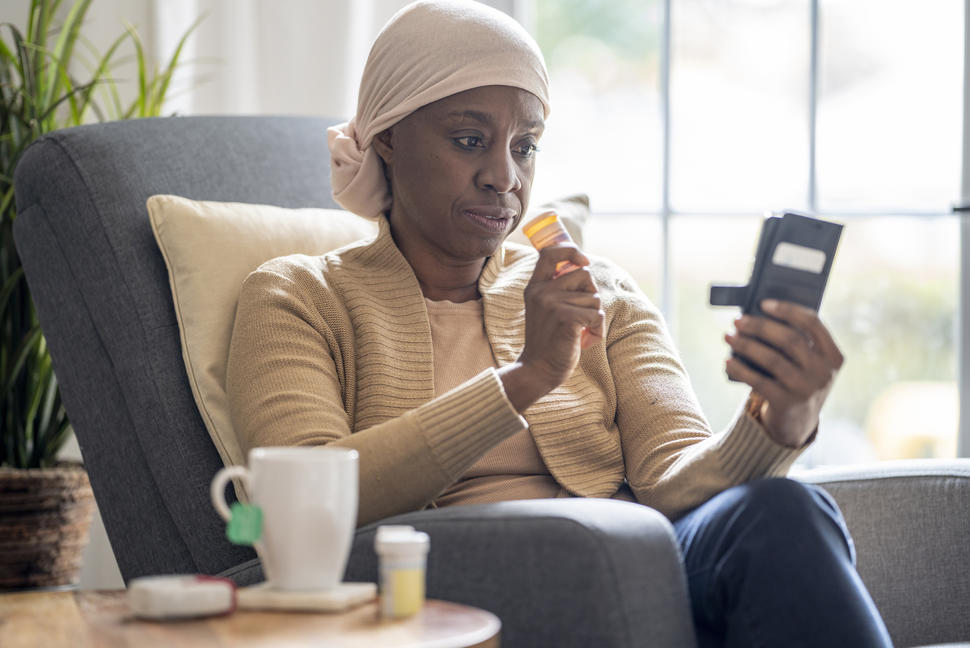Telehealth Can Save People with Cancer Time, Travel, and Money
, by Edward Winstead
Since the start of the COVID-19 pandemic, many people with cancer have had telehealth visits with their doctors. Compared with in-person visits, telehealth may save people with cancer time, travel, and money, a new study suggests.
The findings are based on an analysis of nearly 25,500 telehealth visits by more than 11,600 adults with cancer during the pandemic. The patients were seen virtually by clinicians at the Moffitt Cancer Center, an NCI-Designated Comprehensive Cancer Center in Florida.
The researchers estimated the indirect costs that patients under age 65 saved with telehealth visits compared with the costs of visiting their doctors in person. Indirect costs include travel expenses for medical visits and lost income from missing work due to the time needed for medical visits and travel.
The use of telehealth was associated with an average cost savings of between $147 and $186 per visit for patients, according to findings published January 10 in JAMA Network Open.
“These are substantial amounts of savings that patients and potentially their caregivers can use for other things,” said study coauthor Krupal Patel, M.D., who treats head and neck cancers at Moffitt.
The study also found that telehealth visits patients saved patients an average of 2.9 hours of driving time (round trip) and 1.2 hours of in-clinic time per visit.
Although the study was not designed to explain why telehealth visits were typically shorter than in-person visits, Dr. Patel said the time patients spend parking, registering, and waiting to see a clinician was likely a factor.
Many studies have explored the financial burden of cancer care and the stress it causes—sometimes referred to as financial toxicity. But few studies have focused on the indirect costs to the patient, which can be significant, said Robin Vanderpool, Dr.P.H., of NCI’s Division of Cancer Control and Population Sciences.
“This research on the benefits of telehealth is really encouraging,” said Dr. Vanderpool, who was not involved in the study. “The findings suggest that we should consider using telehealth as a routine part of how we deliver cancer care.”
COVID-19 created an opportunity to assess cost savings from telehealth
The Biden administration announced plans to end the national emergencies declared in response to COVID-19 in May 2023. Since 2020, the public health emergency has given the federal government flexibility to waive or modify certain requirements related to health care, including telehealth.
As the public health emergency ends, the Health Resources and Services Administration will share information about the latest changes to telehealth policies on Telehealth.HHS.gov.
The rapid adoption of telehealth during the COVID-19 pandemic created an opportunity for Dr. Patel and his colleagues to conduct an economic analysis of telehealth visits.
“As clinicians, we’ve been hearing from our patients that telehealth can save time and money for them and their caregivers,” Dr. Patel said. “In this study, we wanted to assess the potential benefits of telehealth using objective data.”
The telehealth visits at Moffitt were initiated by doctors. After determining that a particular appointment could be conducted virtually, a doctor would ask whether the patient was interested in a telehealth visit and had the means to connect remotely.
Moffitt has not distributed devices for telehealth visits. But the cancer center has resources to help providers, patients, and family members connect to meetings and troubleshoot technical issues in real time.
The study focused on patients younger than age 65, because they were more likely than older patients to be employed full time. The median age of participants was 55 years old. Florida residents who had completed telehealth visits between April 1, 2020, and June 30, 2021, were included in the analysis.
Estimating travel costs and lost income from in-person visits
What are the benefits of telehealth for patients under age 65 at a single NCI-Designated Cancer Center over 14 months? At Moffitt Cancer Center, the use of telehealth saved:
- 3.8 million roundtrip travel miles, which equates to traveling 152 times around the earth
- 75, 000 roundtrip driving hours, which equates to 8.6 calendar years
- 3.4 calendar years (nearly 30,000 hours) of time in the clinic
To estimate travel cost savings from telehealth visits, the researchers developed two models; each employed a commonly used reimbursement rate for travel ($0.56 or $0.82 per mile). With two rates, the researchers could develop a range of the savings that resulted from not having to travel. Geolocation tools were used to calculate distances between a patient’s home and Moffitt.
The researchers relied on census tract income data from the American Community Survey to estimate potential lost income from in-person visits. By matching a patient’s address to census tract income data, the investigators estimated the patient’s hourly wages.
According to the cost models, telehealth was associated with nearly $1.2 million savings in otherwise lost income due to driving time and $467,000 savings in lost income due to visit time, for a total estimated savings in lost income of $1.6 million across the 11,600 participants in the study.
For patients who were new to Moffitt or had been treated there previously but were seeing a different specialist at the hospital, telehealth visits saved patients an average of 177.6 roundtrip travel miles, 3.4 hours of roundtrip driving time, and 1.5 hours in the clinic per visit.
But the vast majority of telehealth visits in the analysis—nearly 21,000—were for follow-up care. For these appointments, telehealth saved an average of 142.4 roundtrip travel miles, 2.8 hours of roundtrip driving time, and more than 1 hour in the clinic per visit.
Expanding the use of telehealth for follow-up care
Virtual visits might be particularly well suited for follow-up care, such as checking in with patients as part of their long-term monitoring and survivorship care, Dr. Vanderpool noted.
The researchers also see opportunities to expand the use of telehealth for follow-up care.
“Many of my patients don’t need to come in for postoperative visits,” said coauthor Philippe Spiess, M.D., a senior surgeon and assistant chief of surgery and medical director of Virtual Care who treats genitourinary cancers at Moffitt. “I expect to use telehealth for these visits as part of my daily practice now and in the future.”
The patients who benefited from telehealth visits lived in counties across the state of Florida, including some counties near the cancer center.
“The significant cost savings associated with telehealth that we observed occurred among people who potentially are really busy with daily activities,” Dr. Spiess, said. “They may not be able to leave work or may have some other reason that coming for an in-person visit is a challenge.”
Telehealth gives people “the flexibility to access care when it is convenient,” he added.
Many patients who had telehealth visits at Moffitt scheduled their appointments during a break at work or prior to starting or ending their days, Dr. Patel noted. By comparison, an in-person medical visit can take more than 3 hours in a person’s day.
“For some people, that’s nearly half of a workday just gone,” said Dr. Patel.
Future studies of telehealth and cancer
The current study had some limitations. The researchers noted, for example, that because Moffitt draws patients from across Florida, patients in the study may have had to travel greater distances, on average, than people receiving treatment at other cancer centers or community hospitals.
In addition, some patients receiving cancer treatment might not have been fully employed because of limitations in their ability to work. This fact could alter the estimates of the savings from not having to miss work.
Future studies are needed to determine whether long-term outcomes for patients are equal whether they received care virtually or in person, Dr. Patel noted.
Caregivers are another subject for more research. Because caregivers often coordinate and attend medical appointments with patients, including them in the economic analyses could reveal a greater overall savings from telehealth, the researchers noted.
The researchers have estimated the carbon emissions savings associated with telehealth visits. Telehealth “has important implications in reducing health care–related carbon footprint,” they concluded.
In future publications, Dr. Patel and his colleagues will share their findings on patient perspectives on the quality of telehealth care.
“Telehealth is not a shortcut in cancer care,” he said. “We want to maintain the trust of the patients and provide them with the same quality of care as they receive through in-person visits.”
Building a foundation for telehealth before the pandemic
Before the pandemic, telehealth tended to be used only in certain circumstances, such as when serving rural communities and getting second opinions from providers.
Moffitt began to develop a telehealth program in 2017. “At the time, few patients at Moffitt were interested in connecting with their doctors virtually and the experience was similar to a Skype call,” said Cristina Naso, who directs the Virtual Care Initiative at Moffitt.
But these early efforts laid the groundwork for expanding virtual cancer care when the pandemic hit. By that point, Ms. Naso and her team had developed guidelines for which visits could be done remotely. They had also created awareness about the approach among health care providers across the cancer center.
“When the pandemic began, we fastened our seat belts,” said Ms. Naso. One of the first challenges was “to get everyone on board with what was considered to be best practices in telehealth during a very difficult time,” she added.
Developing evidence to inform decisions about telehealth
Because telehealth was adopted so rapidly at the start of the pandemic, research on how best to incorporate this approach into cancer care has lagged behind.
“Almost overnight, we went from using telehealth as a niche way of delivering health care to making the technology available for all types of patients and providers,” said Dr. Vanderpool.
The U.S. Department of Health and Human Services took administrative steps to encourage the adoption of telehealth at the start of the COVID-19 pandemic. Some of the telehealth flexibilities have been made permanent, whereas others are temporary.
As telehealth continues to be part of cancer care, more research is needed to guide its use, Dr. Vanderpool noted. Studies such as the current one will provide the evidence policy makers need to make decisions about telehealth, she added.
“Time is a commodity that cannot be quantified, especially for people seeking cancer care,” said Dr. Patel. “Time that can be given back to a patient to improve their quality of life is a benefit to the patient and to Moffitt.”
Some of the people who might benefit the most from telehealth include people with minimum-wage jobs, who often have limited flexibility in their schedules.
But these people may lack the equipment they need for telehealth visits, such as broadband at home, noted Roxanne Jensen, Ph.D., of NCI’s Healthcare Delivery Research Program, who was not involved in the Moffitt study.
Since 2021, Dr. Jensen noted, NCI has supported research on the use of telehealth in cancer care through its four Telehealth Research Centers of Excellence (TRACE). A focus of the initiative is on the equitable access to telehealth care and the equitable delivery of telehealth care.
“Although the centers are just getting started, we hope to learn much more about how to ensure that telehealth benefits are available for all patients with cancer,” Dr. Jensen said, adding that the Moffitt study provides “an excellent foundation for future telehealth research.”

